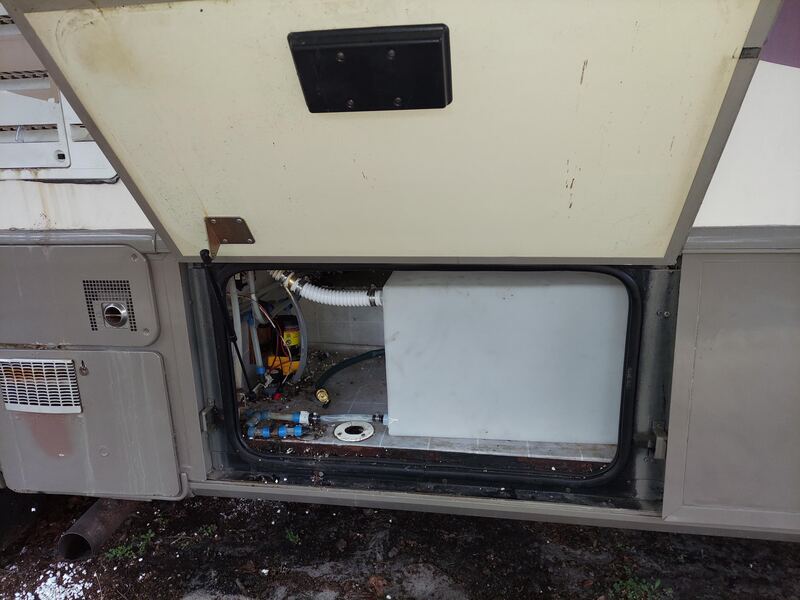Thanks for your support! If you make a purchase using our links in this article, we may make a commission. And, as an Amazon Associate, I earn from qualifying purchases. See the full disclosure here.
Have you ever sanitized your RV fresh water tank? Despite the proper water cleaning methods, you still want to sanitize your RV’s fresh water tank every six months. A sanitized RV freshwater tank gives you the best tasting water that’s free from contaminants, tastes, and smells that may build up over time.
Join us as we explain how and why sanitizing your RV freshwater tank is an important preventive maintenance procedure. We’ll also show you some best practices on keeping your RV freshwater tank clean, various sterilization methods, and how to care for your external plumbing accessories.
How Long Can I Keep Freshwater in My RV Tank?
Experts agree it’s safe to keep fresh water in your RV tank for up to two weeks. But, after that, the stagnant water can develop a bad taste, odor, or worse. Even if you use an RV water filter, bacteria, mold, mildew, and fungal spores can find their way into your plastic RV freshwater tank and contaminate your drinking water.
You can set a reminder on your mobile device or use one of the many RV maintenance applications to remind you to refresh the water every two weeks. During winter storage, RV winterizing antifreeze doesn’t need cycling.
Will Sanitizing My RV Freshwater Tank Get Rid of the Bad Water Smell?
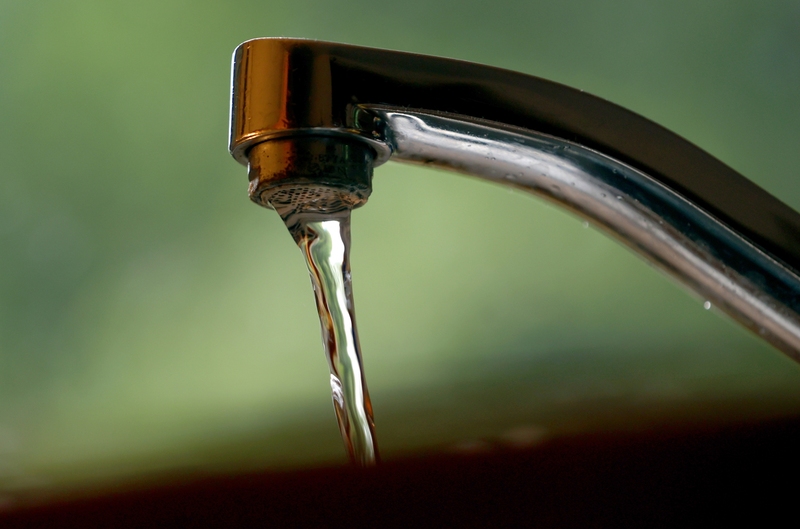
Sanitizing your RV freshwater tank gets rid of the bad water smell and taste. These problems occur due to bacteria growth, chemical compounds like sulfur-oxide, or decaying organics. Using a quality RV water filtration system and avoiding questionable water sources will minimize contaminating your freshwater tank. A one-micron water filter removes particles that are too small to see without a microscope. You’ll find these types of filters in multi-stage RV filtration systems.
What’s the Easiest Way to Keep My Freshwater Tank Clean?
There are many easy ways to keep your freshwater tank clean. To stay on the six-month sanitizing of your RV freshwater tank schedule, add it to your RV preventive maintenance checklist. Also, only fill your RV freshwater tank from water sources you know have good purity levels.
Those living the full-time RV lifestyle and seasonal RVers (especially boondockers) may want to sanitize their RV freshwater tank on a four-month rotation since they use the freshwater holding tank more often.
How Much Time Does It Take To Sanitize Your Tank?
The time it takes to sanitize your RV’s freshwater tank can take as little as a couple of hours to overnight, depending on what you use. There are different treatment options to sanitize your RV freshwater tank. Each cleaning product has a different soaking wait time. The active part of the process is quick and easy.
Regardless of which sanitizer you use, here’s how the process works:
- First, turn off the water heater, water pump, and drain the freshwater tank.
- Add the correct amount of sanitizer to a one-gallon milk jug filled with water. You’ll add 1-4 of these milk jug solutions to your water tank based on its size.
- For example, if you’re using bleach, you’ll use three jugs for a 24-gallon tank.
- Fill your RV water tank entirely with water.
- Open all of your hot and cold faucets in your sinks and showers until you see/smell the sanitizer, then shut off the water.
- Take a short drive or rock your RV for a few minutes to agitate the sanitizer.
- Follow the “Wait Time” instructions, letting the additive do its work.
- Drain your freshwater tank through the quick-release valve. Then refill it with clean water.
- Rerun all of your faucets until you no longer see/smell the sanitizer. Then, drain your freshwater tank again and fill it halfway for your use.
Use a drinking glass to test the water. After a sip, if it still takes like the sanitizer, run another rinse out. By following these steps, you’ve also cleaned the RV water heater, water pump, and plumbing, checking off many boxes with one procedure.
How to Sanitize an RV freshwater Tank Using the Chlorine Method?
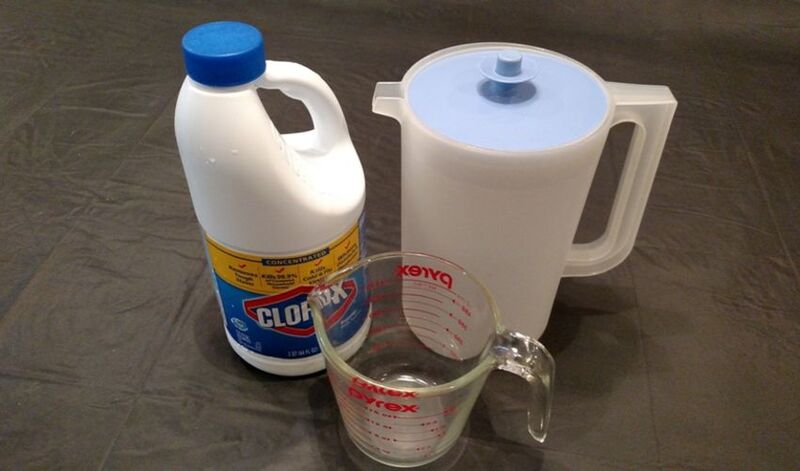
When you sanitize an RV freshwater tank using the chlorine method, the key to success is “safe dilution.” The chlorine you use in your pool is much stronger than bleach. If the solution isn’t thoroughly diluted, the bleach can damage your tank and plumbing. As a safeguard, we recommend working with the less potent sodium hypochlorite in bleach.
- Bleach: ¼ cup per gallon of water for every 15-16 gallons. Wait 8-12 hours.
How to Sanitize Your RV Freshwater Tank Without Chlorine?
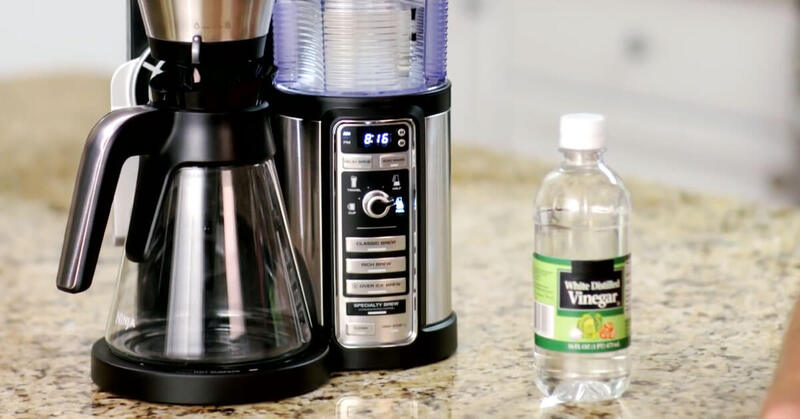
You can sanitize your RV freshwater tank without chlorine using vinegar. Keep the fancy stuff in the pantry, and use white vinegar heated to 130°F (55°C).
Run the vinegar through your coffee maker. You’ll have to do it twice since the first time cleans out the coffee machine’s plumbing. But, it’s a safe and quick way to get the vinegar to the temperature you need. Once you rinse out the coffee maker, you’ll love the quality of the brew.
- Vinegar: Two quarts per gallon of water for every 15-16 gallons. Wait 8-12 hours.
How to Sanitize Your RV Water Tank With Hydrogen Peroxide
Sanitizing your RV water tank with hydrogen peroxide is unrealistic. The convenience store medical version only contains 3%, which is too diluted. Concentrated hydrogen peroxide is a controlled substance that requires the proper permits for commercial use. It’s not worth the hassle of acquiring the good stuff, and it’s highly toxic.
RV Freshwater Tank Sanitizer Products
Sanitizing your RV freshwater tank with ready-made products is a stress-free way to go. The companies that make the best tank sanitizers formulate the cleaners to have the proper pH balance and make them safe to use.
You’ll also find that they include coloring and/or odor additives in their products. They’re easy to rinse out, making the flushing out phase less of a trial. Some come pre-measured as tablets that dissolve in your gallon-size container. Finally, when you look at the active ingredients, a good portion of them don’t use bleach or chlorine, making it safer on your coach’s plumbing.
Camco TastePURE Spring freshwater System Cleaner
Camco has taken all of the hard work and uncertainty out of the equation with their TastePURE Spring Fresh Water System Cleaner. The gallon-size jug comes already pre-diluted and works for freshwater tanks that are 10-100 gallons. The back label has hash marks that show you how much to add. The wait time is only 10 minutes.
Thetford Freshwater Tank Sanitizer Detergent and Treatment
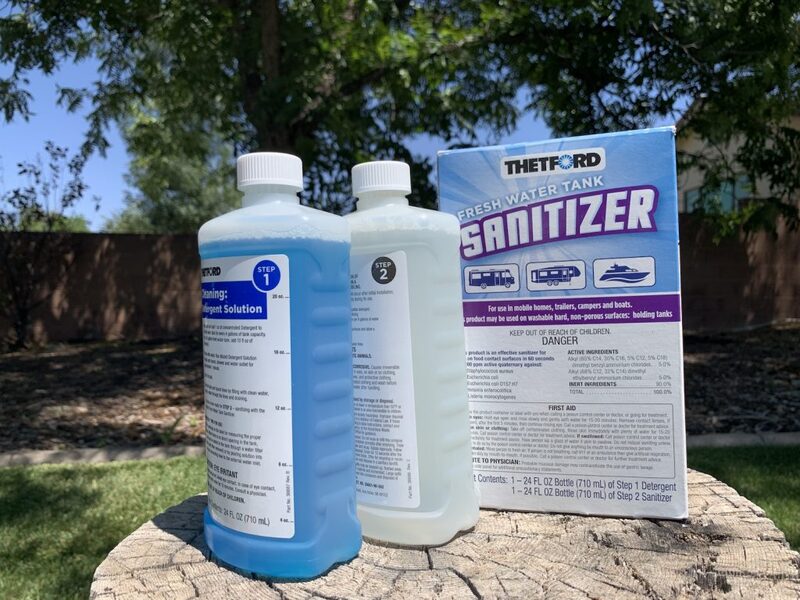
Thetford’s Freshwater Tank Sanitizer Detergent and Treatment is a two-stage cleaning system. The mixture ratio is one ounce per four gallons and the wait time is only a minute. By the time you’ve run it through your faucets, it’s time to flush it out. You start with the detergent and then follow it with the sanitizer using the same ratio and wait time.
“Nervous Nellies” can wait a few minutes longer to let the active ingredients sanitize their RV freshwater tank without harming anything.
Aqua Shock H2O Freshwater Tank Sanitizer/Disinfectant
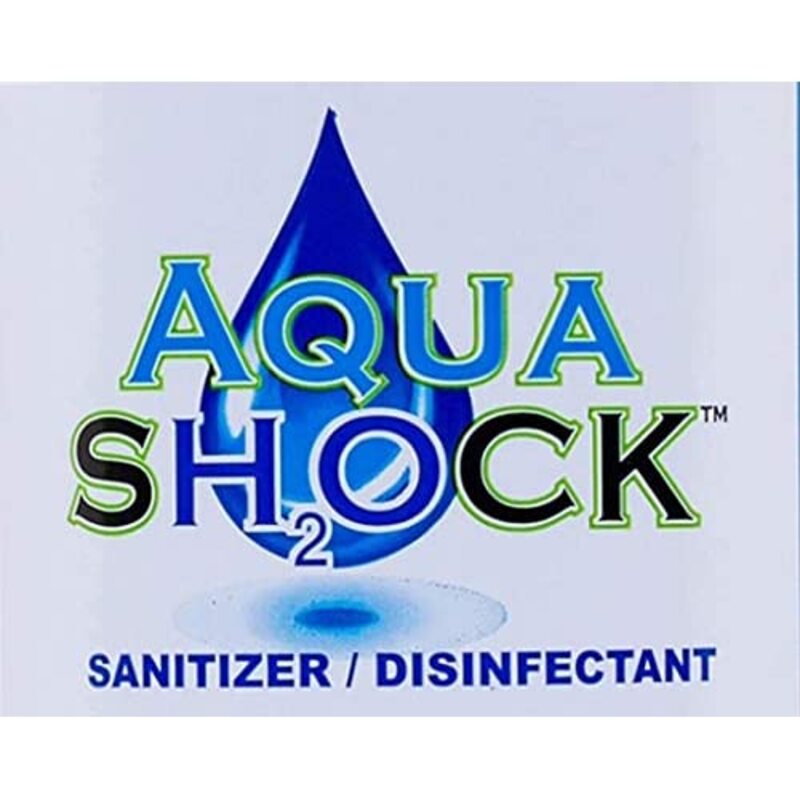
Aqua Shock H2O Freshwater Tank Sanitizer/Disinfectant uses 2% of Chlorine Dioxide as an active ingredient. It’s EPA approved, and major airline carriers have used it over three decades. The ratio is an ounce per 30 gallons with an 8-12 hour wait time.
Star-Brite Aqua Water Treatment & Freshener
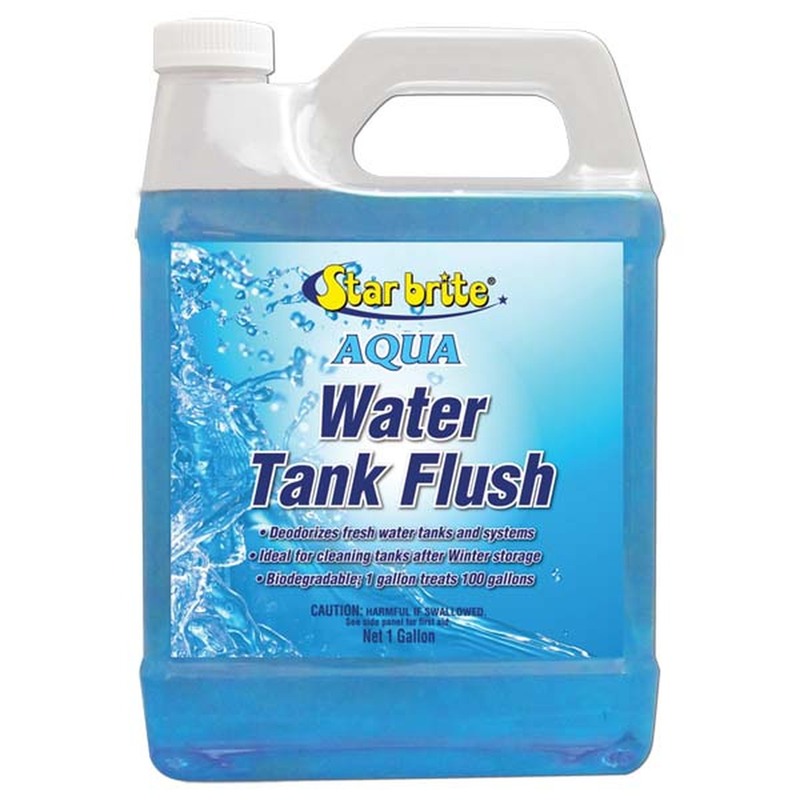
Star-Brite’s Aqua Water Treatment and Freshener come in the concentrated eight or 16-ounce bottle. Use one fluid ounce for 20 gallons and wait 30 minutes before draining. For larger freshwater tanks, they offer a pre-diluted one-gallon jug that’s ready for 100-gallons.
How Should I Store My Water Filters Between Uses?
When you read our article on How to Store an RV Water Filter Between Uses, you’ll learn that the best way to store your RV water filters is to seal them in a zip-top bag and place them in the refrigerator. Keeping it in a cool, dry place prevents mildew or microorganisms from growing inside. Never use bleach or sanitizing products on RV water filters. The chemicals can damage the filtering agents.
Do I Need to Sanitize My Freshwater Hose?
The need to sanitize your freshwater hose is essential to clean and protect the liner. If you’ve read our articles about storing your RV freshwater hose in a sealable storage bin, pour some of your sanitizer mixtures into the container, fill it with water and give your hose a spa treatment for a few minutes.
Afterward, flush the hose out with clean water from a reliable water source. Don’t forget to connect the water filter! When you’re ready to pack up, make sure your freshwater hose bin is dry. Once the hose is drained and coiled, pack it away, screwing both ends together.
What’s the Best Way to Ensure My RV Drinking Water is Safe?
The best way to ensure your RV drinking water is safe is to install a UV-LED water purification system like the Acuvatech ArrowMax devices. These energy-efficient systems make your filtered water 99.9999% microorganism-free. One UV-LED system can serve your entire motorhome or travel trailer, regardless of RV size and features. With a buy good for the long haul affordable price, virtually any campground water source can be trustworthy.
Should I Sanitize My RV Holding Tanks?
You don’t need to sanitize your RV holding tanks that collect your black and grey water, but there are steps you can take to clean and deodorize them. In the July issue of RV Camping Magazine, a FREE digital magazine we offer to everyone, the National RV Training Academy talks about what you can do to avoid the poop pyramid that builds up in your black tank.
Related Reading:
How to Flush and Clean RV Holding Tanks
6 Best RV Water Pressure Regulators to Prevent RV Plumbing Leaks
115 Point RV Inspection Checklist (New or Used)
How Often Should I Change My RV Water Filter?
Do Tankless RV Water Heaters Provide Endless Hot Water?
Brian Newman – Author and Full Time RVer
Although he’s from Motown, Brian Newman is a legacy RVer that grew up on I-75. He, and his wife have enjoyed the full-time RV lifestyle since 2017.
Like John Madden, he hasn’t “worked” in years because he gets to write about his passion. When he’s not working, he supports his daughter’s dog rescue efforts and disability causes.


